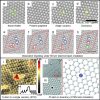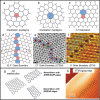Controlling defects in graphene for optimizing the electrical properties of graphene nanodevices
- PMID: 25864552
- PMCID: PMC4415450
- DOI: 10.1021/acsnano.5b01762
Controlling defects in graphene for optimizing the electrical properties of graphene nanodevices
Abstract
Structural defects strongly impact the electrical transport properties of graphene nanostructures. In this Perspective, we give a brief overview of different types of defects in graphene and their effect on transport properties. We discuss recent experimental progress on graphene self-repair of defects, with a focus on in situ transmission electron microscopy studies. Finally, we present the outlook for graphene self-repair and in situ experiments.
Figures



Comment on
-
Electronic transport of recrystallized freestanding graphene nanoribbons.ACS Nano. 2015;9(4):3510-20. doi: 10.1021/nn507452g. Epub 2015 Mar 9. ACS Nano. 2015. PMID: 25738404
References
-
- Haskins J.; Kınacı A.; Sevik C.; Sevinçli H.; Cuniberti G.; Çağın T. Control of Thermal and Electronic Transport in Defect-Engineered Graphene Nanoribbons. ACS Nano 2011, 5, 3779–3787. - PubMed
-
- Tsen A. W.; Brown L.; Levendorf M. P.; Ghahari F.; Huang P. Y.; Havener R. W.; Ruiz-Vargas C. S.; Muller D. A.; Kim P.; Park J. Tailoring Electrical Transport Across Grain Boundaries in Polycrystalline Graphene. Science 2012, 336, 1143–1146. - PubMed
-
- Stampfer C.; Güttinger J.; Hellmüller S.; Molitor F.; Ensslin K.; Ihn T. Energy Gaps in Etched Graphene Nanoribbons. Phys. Rev. Lett. 2009, 102, 056403. - PubMed
-
- Lherbier A.; Dubois S. M.-M.; Declerck X.; Niquet Y.-M.; Roche S.; Charlier J.-C. Transport Properties of Graphene Containing Structural Defects. Phys. Rev. B 2012, 86, 075402.
-
- Lahiri J.; Lin Y.; Bozkurt P.; Oleynik I. I.; Batzill M. An Extended Defect in Graphene as a Metallic Wire. Nat. Nanotechnol. 2010, 5, 326–329. - PubMed
Publication types
MeSH terms
Substances
LinkOut - more resources
Full Text Sources
Other Literature Sources

